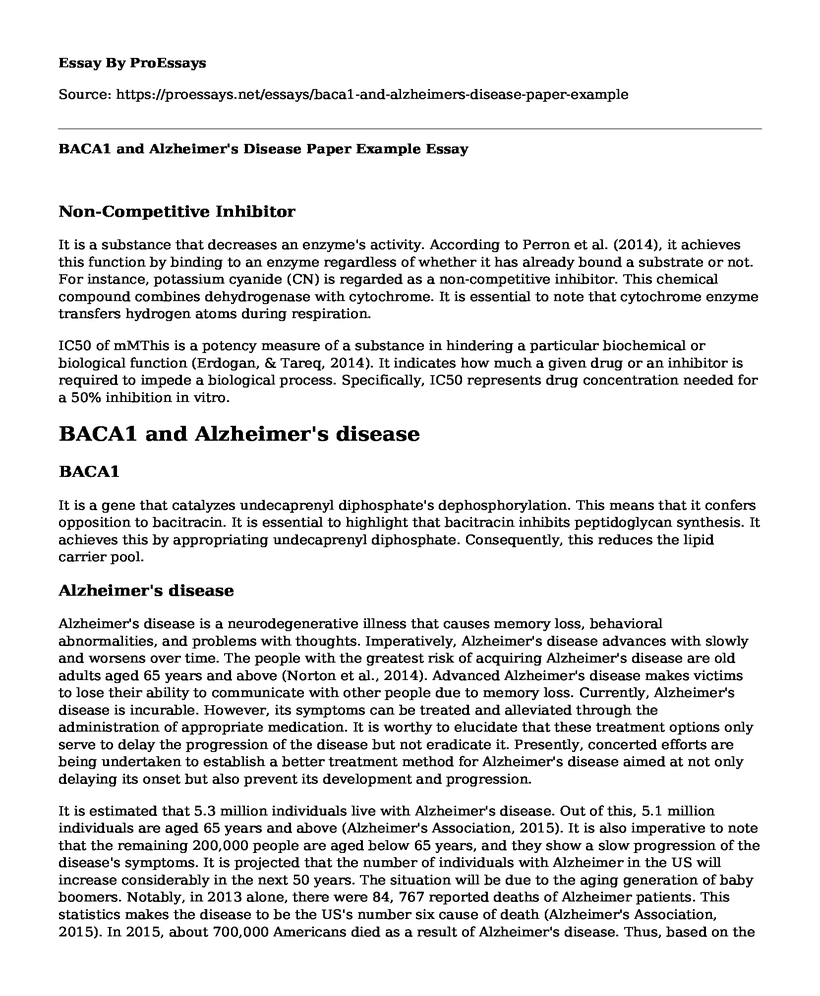Non-Competitive Inhibitor
It is a substance that decreases an enzyme's activity. According to Perron et al. (2014), it achieves this function by binding to an enzyme regardless of whether it has already bound a substrate or not. For instance, potassium cyanide (CN) is regarded as a non-competitive inhibitor. This chemical compound combines dehydrogenase with cytochrome. It is essential to note that cytochrome enzyme transfers hydrogen atoms during respiration.
IC50 of mMThis is a potency measure of a substance in hindering a particular biochemical or biological function (Erdogan, & Tareq, 2014). It indicates how much a given drug or an inhibitor is required to impede a biological process. Specifically, IC50 represents drug concentration needed for a 50% inhibition in vitro.
BACA1 and Alzheimer's disease
BACA1
It is a gene that catalyzes undecaprenyl diphosphate's dephosphorylation. This means that it confers opposition to bacitracin. It is essential to highlight that bacitracin inhibits peptidoglycan synthesis. It achieves this by appropriating undecaprenyl diphosphate. Consequently, this reduces the lipid carrier pool.
Alzheimer's disease
Alzheimer's disease is a neurodegenerative illness that causes memory loss, behavioral abnormalities, and problems with thoughts. Imperatively, Alzheimer's disease advances with slowly and worsens over time. The people with the greatest risk of acquiring Alzheimer's disease are old adults aged 65 years and above (Norton et al., 2014). Advanced Alzheimer's disease makes victims to lose their ability to communicate with other people due to memory loss. Currently, Alzheimer's disease is incurable. However, its symptoms can be treated and alleviated through the administration of appropriate medication. It is worthy to elucidate that these treatment options only serve to delay the progression of the disease but not eradicate it. Presently, concerted efforts are being undertaken to establish a better treatment method for Alzheimer's disease aimed at not only delaying its onset but also prevent its development and progression.
It is estimated that 5.3 million individuals live with Alzheimer's disease. Out of this, 5.1 million individuals are aged 65 years and above (Alzheimer's Association, 2015). It is also imperative to note that the remaining 200,000 people are aged below 65 years, and they show a slow progression of the disease's symptoms. It is projected that the number of individuals with Alzheimer in the US will increase considerably in the next 50 years. The situation will be due to the aging generation of baby boomers. Notably, in 2013 alone, there were 84, 767 reported deaths of Alzheimer patients. This statistics makes the disease to be the US's number six cause of death (Alzheimer's Association, 2015). In 2015, about 700,000 Americans died as a result of Alzheimer's disease. Thus, based on the above statistics and figures, it is essential to assert that the number of people with this disease has been on the rise in the US.
EGCG Compound and Alzheimer's disease
EGCG is an acronym of epigallocatechin gallate, and it is a phenolic antioxidant compound found in black and green tea. It has a molar mass of 458.372g/mole and a chemical formula of C22H18O11. The organic structure of EGCG is as shown in figure 1 below.
This compound inhibits cellular oxidation as well as preventing radical damage to body cells. EGCG helps in reducing the susceptibility of Alzheimer's disease. It inhibits the development of beta-amyloid plaques by interfering with how beta-amyloid oligomers function.
References
Alzheimer's Association. (2015). 2015 Alzheimer's disease facts and figures. Alzheimer's & Dementia: The Journal of the Alzheimer's Association, 11(3), 332.
Erdogan, O.I., & Tareq, H.K.M. (2014). Flavonoid derivatives as potent tyrosinase inhibitors-A survey of recent findings between 2008-2013. Current Topics in Medicinal Chemistry, 14(12), 1486-1493.
Norton, S., Matthews, F. E., Barnes, D. E., Yaffe, K., & Brayne, C. (2014). Potential for primary prevention of Alzheimer's disease: an analysis of population-based data. The Lancet Neurology, 13(8), 788-794.
Perron, M., Chowdhury, S., Aubry, I., Purisima, E., Tremblay, M. L., & Saragovi, H. U. (2014). Allosteric non-competitive small molecule selective inhibitors of CD45 tyrosine phosphatase suppress T-cell receptor signals and inflammation in vivo. Molecular Pharmacology, mol-113.
Cite this page
BACA1 and Alzheimer's Disease Paper Example. (2022, Oct 05). Retrieved from https://proessays.net/essays/baca1-and-alzheimers-disease-paper-example
If you are the original author of this essay and no longer wish to have it published on the ProEssays website, please click below to request its removal:
- Analysis of Non-profit Hospital - Paper Example
- Argumentative Essay Sample on Abortion
- Essay Sample on Military Healthcare Practitioners' Dual Loyalty Dilemma: Confidentiality & Ethics
- Essay Sample on COVID-19: Global Public Health Emergency & Its Origin
- Essay Example on Abortion Debate: Pro-Choice vs Pro-Life
- Paper Sample on Seniors in Canada: Healthier and Longer Lives Thanks to Gov't Care
- Free Essay Sample on Modernizing Hammington's Healthcare Services: A Necessity







